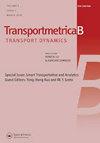固定路线需求响应公交的放松方法
IF 3.4
2区 工程技术
Q2 TRANSPORTATION
引用次数: 0
摘要
本文研究了一种部分响应的拼车公交服务,该服务具有预定的循环路线和确定的出行时间。主要的运营挑战是制定时间表,根据前期乘客的要求,时间表每天都会有所不同。乘客需要根据其期望值调整出发时间,这会造成不便,我们希望将其降至最低。先前对固定路线拨号乘车问题(FRDARP)的研究考虑了严格的车队约束。通过嵌入SMAWK算法的有效动态规划,我们解决了与一维p-中值定位问题有关的两个松弛公式。数值结果显示了FRDARP与固定时间表(传统)服务相比的潜在优势,并说明了需求水平和车队约束的影响。此外,基于这些结果,我们描述了广泛的场景,在这些场景中,更容易求解的松弛公式几乎与约束公式一样有用。本文章由计算机程序翻译,如有差异,请以英文原文为准。
Relaxation methods for fixed route demand responsive transit
This article examines a partially responsive ride-sharing transit service with predetermined cyclic routes and deterministic travel times. The main operational challenge is setting the time schedule, which varies from day to day in response to upfront passenger requests. The need of passengers to adjust their departure times from their desired value causes inconvenience, which we wish to minimize. A previous study of the fixed route dial a ride problem (FRDARP) considered strict fleet constraints. We solve two relaxed formulations, related to the one-dimensional p-median location problem, by efficient dynamic programming embedding the SMAWK algorithm. Numerical results show the potential benefit of the FRDARP compared to fixed schedule (traditional) service and illustrate the impact of demand level and fleet constraints. In addition, based on these results, we characterize the wide range of scenarios where an easier to solve relaxed formulation can be nearly as useful as the constrained formulation.
求助全文
通过发布文献求助,成功后即可免费获取论文全文。
去求助
来源期刊

Transportmetrica B-Transport Dynamics
TRANSPORTATION SCIENCE & TECHNOLOGY-
CiteScore
5.00
自引率
21.40%
发文量
53
期刊介绍:
Transportmetrica B is an international journal that aims to bring together contributions of advanced research in understanding and practical experience in handling the dynamic aspects of transport systems and behavior, and hence the sub-title is set as “Transport Dynamics”.
Transport dynamics can be considered from various scales and scopes ranging from dynamics in traffic flow, travel behavior (e.g. learning process), logistics, transport policy, to traffic control. Thus, the journal welcomes research papers that address transport dynamics from a broad perspective, ranging from theoretical studies to empirical analysis of transport systems or behavior based on actual data.
The scope of Transportmetrica B includes, but is not limited to, the following: dynamic traffic assignment, dynamic transit assignment, dynamic activity-based modeling, applications of system dynamics in transport planning, logistics planning and optimization, traffic flow analysis, dynamic programming in transport modeling and optimization, traffic control, land-use and transport dynamics, day-to-day learning process (model and behavioral studies), time-series analysis of transport data and demand, traffic emission modeling, time-dependent transport policy analysis, transportation network reliability and vulnerability, simulation of traffic system and travel behavior, longitudinal analysis of traveler behavior, etc.
 求助内容:
求助内容: 应助结果提醒方式:
应助结果提醒方式:


